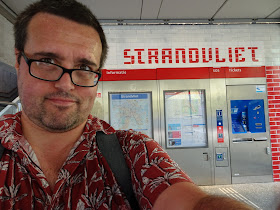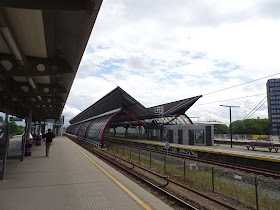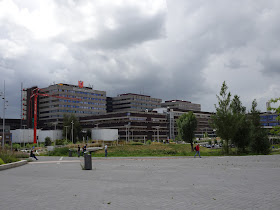I was, in truth, getting tired of the Amsterdam Metro. (Reader's voice: YOU'RE TIRED?) Not tired of the stations, not tired of the city, but just tired of the relentlessness. This was, don't forget, meant to be a leisurely three day quest, and instead it was crammed into two. Add in the general stress of it all and my brain was getting a little fritzed. On top of that, my feet ached. I'd not worn my big sturdy walking boots because I wanted to get through airport security without any problems; the trouble is, now I was learning that Vans aren't really built for pounding the pavement, and they're certainly not very good when it comes to cobbles.
I uncurled myself from the seat on the train and stiffly walked towards the escalators at Amsterdam Bijlmer ArenA station. (Yes, that final A is a capital as well, work with it). At least it was an impressive station. Comprehensively rebuilt in 2007, there's an intriguing mix of colours and textures that really impress.
There's something quite sci-fi about it, quite
Star Wars-y; those shooting roof pieces feel like they could be the roof of an X-Wing hangar. Deep voids lead down to the passenger concourse.
All this space is, of course, to accommodate the thousands of people who pass through on their way to the complex of entertainment spaces just outside. Amsterdam put in a bid for the 1992 Olympics, the ones that went to Barcelona, and the centrepiece was a brand new stadium here in Bijlmer. Though that failed - Amsterdam went out in the first round, before Birmingham - the spot was still suitable for a new football ground for Ajax.
Even I've heard of Ajax. They're one of those European teams you can name off the top of your head, like Spartak Moscow or Real Madrid or Borussia Mönchengladbach. Ajax have won the European Cup/Champions League four times, and that is the beginning and end of the football chat here, because even looking at the Wikipedia page for them bored me senseless. All I wanted to know was if they were any good and suddenly I'm being bombarded with tedious stats and factoids. (Also, the last time I tried talking about football,
Queen of Women's Soccer Carrie Dunn swept in and corrected all my points about
Manchester City Women, so I'm not doing that again).
The plaza outside the station is very Wembley; a series of alluring traps to get people to spend money on their way to and from an event. The night before I visited, Coldplay had played; I believe they're a very popular beat combo. I mean, I know
who Coldplay are, I've just never heard one of their songs and had it permeate into my brain to the extent that I recognise it as a Coldplay song. Actually, that's not quite true - there was an advert for BMW that played before
No Time To Die and on about the sixth viewing of it I found myself pulling out my phone and Shazaming to find out who was doing the music. It turned out it was Coldplay's
Higher Power, but I wouldn't take that as a win for Chris Martin, because I also became enamoured with the music they used for the
Matrix Resurrections and
House of Gucci trailers; I'm in a very vulnerable state when there's a new Bond film about to play.

The music venue next to the stadium had posters showing people who'd previously played there and - hang on, who's that next to Sting?
I felt strangely proud seeing
Trixie & Katya there with the greats. Those weird little Season 7 Drag Race queens - who didn't even win - were now featured artistes. This must be what it feels like to buy a band's first album and then see them explode a few years later. I know gay culture permeating mainstream Dutch society is hardly a revolutionary concept - even I was starting to get bored of the rainbow flags everywhere - but it was a nice reminder that not everywhere in the world has lost its mind over drag queens. They're entertainers, Barbara, and they're not here to groom your kids.
I walked down a side road, past a restaurant called
Burger Bitch because we can no longer have nice things. A cafe had put out a board:
"Why have abs when you can have Kurio's kebabs?" and here, have a link
Kurio, because that sort of marketing must be supported. There were also public urinals, cross shaped plastic depositories for those attending the events to use, because men are disgusting.

Round the front of the arena was a statue to the most famous Dutch player of all, Johan Cruijff, the man the stadium was named after. There'd been calls to dedicate the stadium to him from the start, but the City of Amsterdam has - in my opinion, very sensible - rules against naming items after living people. You can't risk the person turning out to be a later in life arsehole - imagine if there was a JK Rowling Bridge or a Right Said Fred Park or an Elon Musk Penitentiary (actually I would support that one). After Cruijff died, however, the family gave permission for it to be renamed in his honour (and please note that I'm using the correct Dutch spelling of his surname, not the internationally used version of
Cruyff).
I have to be honest - the stadium's not a looker. While the
Amsterdam Olympic Stadium is a classic design, one that was highly influential throughout the world, the Johann Cruijff ArenA is a hulk, a big heavy lump. A retractable roof means it has strong braces arcing over the top and much of its exterior was covered with commercial advertising. It has none of the charm or elegance of, say, Anfield, though I will say the experience of arriving and departing and the immediate environs are infinitely better. I'm looking forward to all those Eurogays who fell for Liverpool during Eurovision heading to the city again for Taylor Swift and then having to deal with the Sheil Road Circular and the somewhat "earthy" pubs outside.
It was while I was stood there among happy families who'd just paid twenty three Euros for a
pair of socks in the club shop that I realised I'd not taken a picture in front of the station sign. It's no exaggeration to say my stomach lurched in horror. That's how tired I was - I was forgetting the essentials of my trip. I'd been so keen to take a picture of the stadium when I left the station I'd completely forgotten about it. I dashed back, walking twice as fast, a slight sense of panic inside being quashed by the reassurance that I would soon sort it. Imagine I had got home to England, downloaded all the photos... and realised one sign was missing. It would have been a tragedy.

Phew.
Now I had to trek back the way I came, past those same smiling families, only a bit sweatier and more panic ridden than I was before. On the way I passed the ArenA's other station, tucked round the back and simply called Halte Amsterdam ArenA. This is a single platform, only accessible from the direction of Diemen Zuid, which exists purely to separate, shall we say, contentious fans from one another. If there's a game between Ajax and one of its fiercer rivals, the other station can be brought into use, allowing the away fans into the stadium via a purpose built bridge that keeps them well apart from the home fans.

I hate that we have effectively normalised this behaviour. That we have, as a society, simply accepted that if you get a load of football fans together they might fight and attack one another, and what we should do is build physical barriers and architectural get outs to mitigate the damage. I bet Trixie and Katya's fans didn't have to be corralled and guarded in case a tranche of manic Violet Chachki supporters came running over the hill, ready to pulverise them with sharpened stiletto heels.

A walk past more football pitches brought me to Strandvliet station, ArenA's little brother and a handier station to use if you don't want to go anywhere near the commercial quarter. Much like Sandhills will soon be to the new Everton stadium, Strandvliet was a quiet station that got a massive tourist attraction dropped on its doorstep. They hastily rebuilt it to accommodate the crowds, with a special entrance for match days - something I sadly don't think is going to happen at Sandhills. No, that's not fair; apparently it's going to get a special Fan Queuing Area. So that's alright then.
One thing I forgot to mention about the refurb of the Oostlijn stations was the coloured glass entrance. Above the open front, a high window was put in with abstract glass colours. It let more light into the ticket hall and also gave each station its own identity. At Strandvliet there were rainbow colours, which extended to the windows over the escalator as you ascended to the track.
Duivendrecht came into existence because of its location. There wasn't anything here until 1993; the trains went on to Van de Madeweg, which was known as Duivendrech Centraal because, well, it was in the middle of Duivendrecht. However, the Ringspoorbaan - a rail line from Schiphol across the south of the city - was constructed in the early 90s, and at the point where it met the metro line, they built an interchange.
It very much feels like a station that was constructed because they thought they should, rather than there being a specific need for it. It's big and airy and full of glass and steel, but it doesn't feel like a hub. I got off the train with one other person, who went down and through the gates alongside me and waited outside to be picked up by a friend. He looked at me a little askew, as though he was surprised to see anyone else there.
There's space for buses outside, and a park and ride, but both were unpopular with the public. Eurolines operate coaches from here, but that's about it. I walked outside and took my picture under the ostentatious sign.
The road out of the station complex is long and straight and really quite dull. I think it says a lot about the amount of pedestrian usage it gets that a tree had fallen across the footpath and nobody had thought to move it. It had been there long enough for most of its green leaves to turn brown. The highlight was a heron, which stood on the path and watched me approach with a certain amount of arrogance. It didn't seem inclined to move, as though I encroaching on his territory, and I was within a metre or two and wondering if it was possible or even wise to pet a heron when he lifted his wings and lazily flew off and into the trees.
I was deposited on a huge junction with a massive depot for the postal service, but I turned right, past small units and car dealerships. The grinding engines of the city. I crossed another street, and then swore, quite loudly.

I'd been here before.
A few hours ago, in fact. I'd thought I was simply in another industrial estate but no, there was that cash and carry again, and there were the pictures of food again, and then I was passing under the motorway with the lollipops painted on the supports and the big silver sewage machine was up ahead.
I felt terribly disheartened. I was tired and sweaty and grumbly, and now here I was on the same grimy strip of traffic blasted tarmac. It was my own fault of course; if I'd turned left out of Van der Madeweg station this morning, I would've gone a far more interesting route. I could've gone through a housing estate where all the streets were named after space - Lunaweg and Meteoor and Astronautenweg - and maybe gone to the Duivendrecht precinct on Telstarweg. Then the metro junction and the pumping station would've been a nice surprise in the afternoon. I'd planned badly.

I crossed the road, going between gaps in the traffic rather than pushing the button, because I was knackered and dejected. The road shadowed the metro line, and I passed a group of enthusiastic looking young people in hi-vis jackets and helmets being marshalled by a man from the GVB; I wondered if they were engineering students, or apprentices with the transport network. They were far too pretty to be fellow train nerds.

Two men stopped their conversation as I passed, leaning on their parked BMWs and watching me suspiciously, pausing in whatever illicit trade they were engaged in. I feigned disinterest, while secretly wanting to know everything about what they were up to, and walked up to the station at the end of the road.
Overamstel was added to the network in the 90s, when the Amstelveen tram-train line came into existence, and now it's a handy spot to change between the green 50 and the orange 51. We'd moved off the Oostlijn now, onto the newer line I'd mainly collected the day before, and so it didn't get the same refurb. This meant, sadly, no tiled station name. Instead I had to put up with a shiny one under the viaduct.
I promise you that says Overamstel up there. I didn't know the sunshine was exactly on it when I took the photo. Look, I've fiddled with the colours, and you can clearly see a stel.
Once again, if you want me to go back and get a proper photo of the sign, feel free to send cash to my
Ko-fi.
This was it. One more train journey and I'd have done it. Every station on the Amsterdam Metro, collected, visited, photographed. Two days and a lot of walking. I was tired but exhilarated. This was genuinely one of the best things I have done in my life
(Reader's Voice: Jesus Christ) and I enjoyed every second of it. In some ways, I didn't want it to end. In others, I was glad it was over.

Towers and glass told me I was back in the business district of the city. This was Amsterdam Rai, the station for the conference complex I'd been to a million years ago when I did the
Nord-Zuidlijn. The 52 passes right underneath Rai station but they didn't build an interchange, instead putting Europaplein station directly outside the convention centre and removing the lengthy walk passengers on the 50 and 51 needed to take.
It was another rail/metro hub, though rather better used than Duivendrecht. I followed the crowds down, thinking of how I'd shared a lift with two of the delegates for the dementia conference at the RAI in the hotel that morning, and they had studiously avoided making eye contact, even though they were both wearing lanyards showing they were going the same place. I walked out into the road outside the station, raised my camera, and took my last Amsterdam station selfie.




















































